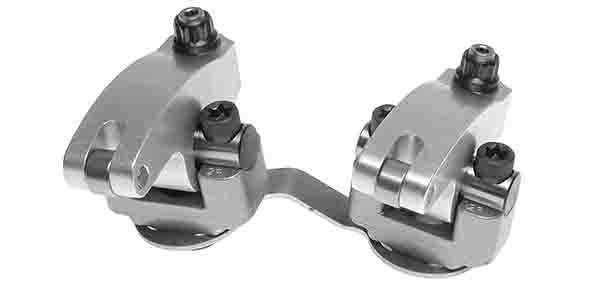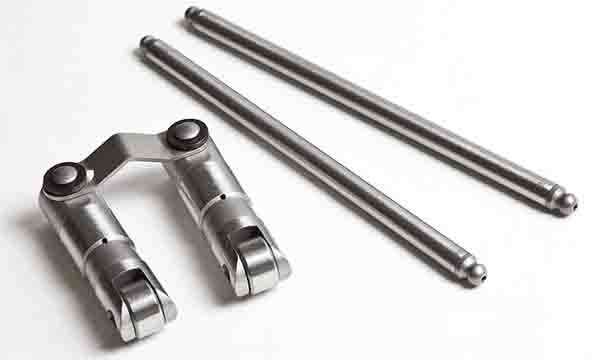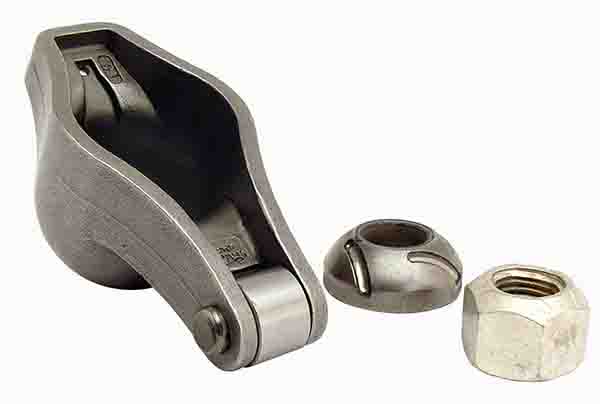Internal combustion engines have many moving parts. Most are intentional by design, but there are also factors that can produce unwanted movement of components that will affect power output, service life and possibly lead to engine failure.
One of the areas that greatly benefits from keeping everything in its proper position is the valvetrain, so let’s look at what can be done to help ensure that. Any time a part physically bends or distorts from its original shape or position (an occurrence known as deflection) it adds additional tension within the system when it returns to normal through rotation or movement. For example, we all know how the valve spring works to keep the lifter in contact with the camshaft lobe for the correct opening and closing rates of the valves. If there is deflection in the push rods, it will add to the spring effect by releasing that extra tension when it returns to its normal shape as the valve is closing.

There are so many variables in modern performance engines that to lay out specific guidelines would be virtually impossible, but your primary focus should be to achieve a balance between rigidity and weight or mass with properly matched internal components.
Often when a stronger or more rigid engine part is utilized it is heavier than the component it is replacing. This is most often the case when replacing OEM parts with performance improving aftermarket pieces. An example of this would be when switching from flat tappets to roller lifters. There are many lightweight roller designs but none will be as light as the flat tappet so this will change the mass that must be controlled for proper function.
Another example in the same train of thought concerning weight is that for many years we believed it was advantageous to use a lightweight push rod in performance engines. However, the rigidity factor achieved by utilizing larger diameter, thicker-wall units that eliminate deflection negates the concern of weight benefits. In any areas that could be questionable or force a design compromise between the two, always go for rigidity over weight savings. There are some specific areas that will provide additional power by shaving some weight but it usually isn’t worth giving up stability or risking a failure to get it.
Weight Factors
The weight of your valvetrain components play a bigger role on the spring side of the rocker arms as opposed to the push rod side. Reducing the weight of the valves, valve springs, retainers and rocker arms can reward you with an overall package that is easier to control in terms of stability.
Hollow stem valves are a good alternative to their solid stem counterparts in high performance engines. Titanium valves are the best choice for full competition applications due to the considerable weight savings. Yes, titanium is expensive but let’s consider long-term advantages. Due to the inherent weight reduction, titanium valves have less inertia to deal with which enables you to utilize less valve spring rate.
Less spring rate reduces the pressures exerted on the rest of the valvetrain, which not only gives you more engine performance, but also lowers service and maintenance costs by reducing valvetrain wear. Modern technology and designs have given us valve springs that not only produce the pressures required for performance and competition applications but also provide substantial reductions in physical mass.
Lightweight tool steel or titanium spring retainers are another part that can provide exceptional strength and considerable weight savings. Using lighter weight aluminum roller rocker arms also aids in improving the overall valvetrain assembly. Die cast rockers are a good choice for performance and limited competition builds. Extruded and custom alloy rockers should be used in applications that will see higher RPM’s and spring pressures.

Physical Factors
The engine itself plays a big role in valvetrain components and function. Block deck height, camshaft location, rocker height and valve stem length all affect the proper part selection in terms of operational stability. You only need to look as far as current Pro Stock engine designs to see examples of this. The deck heights are much lower than older styles and the camshaft location has been raised significantly in the block in conjunction with a larger cam bore. These changes serve several purposes but in the valvetrain area it added a tremendous amount of stability. Bigger cam cores can be used to overcome flexing and shorter, larger diameter push rods that won’t deflect under the elevated RPM’s and pressure. This is a higher end example but it shows us a clear picture of the importance in proper valvetrain function regarding power production. There are always limitations in every design, particularly if you’re dealing with OEM spec components, but you can still optimize your builds by careful part selection.
Hard Parts
Camshafts with a larger base circle will be stronger if you have room in which to fit them. In some engines, such as a small block Chevy stroker build with stock cam location, you will be limited due to clearance issues with the connecting rods but billet cams can offer very good strength levels even with small base circle designs. Keep in mind that higher lifts and aggressive ramp profiles will dictate increased valve spring pressures. Consulting with the cam manufacturer of your choice will help you achieve the right match.
Moving on to the lifters we find almost infinite choices available here, including flat tappet and roller hydraulics with various metering rates to accommodate high revving or sustained high RPM operation as well as specific designs that can handle higher spring pressures.
Flat tappet mechanicals with or without EDM holes for additional lubrication in standard and lightweight designs are made with high quality materials. Mechanical rollers can be had in tie-bar style, full body, cut away body, keyed, needle bearing, bushing, even drop in replacements if you want to install a solid roller cam in a OEM roller block using the factory retention hardware. Also, add to that the various materials and roller diameters they are available with along with the ability to use offset push rod cups for better clearance or alignment. You can quickly see that there is a lifter for every type of build imaginable.
Now let’s connect the lifters to the rockers with some push rods. As we briefly touched on earlier, these are important parts to keeping valvetrain operation consistent. Even in milder performance builds it is good insurance to invest in a set of higher-strength push rods. Better quality chrome moly construction with a minimum wall thickness of .065˝ would be the very least that I would recommend for any performance street build. The next step up would be .080˝ wall, preferably with one-piece construction. Remember, it doesn’t take an excessive amount of spring pressure or RPMs to get an inadequate push rod to flex.Competition applications should utilize the largest and strongest that can be fitted to the engine and give sufficient clearance to the block and cylinder heads. Dual taper push rods can also help in some applications with fitment issues.
One last comment on push rods that I can’t stress enough is to make sure the length is correct. Rocker arm geometry is crucial. Always measure using the rockers and lifters that will be installed on the engine to make sure you get the right length. Don’t assume that just because a catalog shows a certain push rod length for an engine application that it is the correct length for yours. Aftermarket cylinder heads have varying heights for rocker studs depending on brand and head design. Decking the block to work with the compression height of your pistons, compressed head gasket thickness and lifter heights all come into play on push rod lengths. The only way to be completely sure is to measure.

Now we’ll finish off with the rocker arms. There are many choices here too, such as aftermarket factory designs with stronger materials and heat-treating, roller tip and full roller stud- or shaft-mount. You also have your choice of aluminum or steel as well when selecting roller rockers. Some circle track and drag racing classes have rules regarding which rocker arm is allowed but for the most part the selection is up to the engine builder. Utilizing a roller tip or full roller rocker will provide a reduction of the friction in the valvetrain. Stud-mounted roller rockers are an excellent choice for performance and competition builds.
Most rollers are available in different ratios, which allow you to tailor the lift specs of the cam and opening/closing rates of the valves. They are also available with offsets to provide additional block and cylinder head clearance for the push rods or to correct push rod placement. Stud-mounted rocker arms can also be affected by flexing issues in higher output and competition engines. One way to help control this is to use a stud girdle. A girdle physically links all the rocker studs together and provides additional support to help stabilize the rockers.
The next step up from this would be shaft-mounted rockers. Shaft-mounted rocker arms offer the highest level of stability and performance enhancement. These are secured with two bolts, one on each side of the rocker arm, with the rocker itself rotating on a steel shaft as opposed to a rocker stud. There are inline designs also that have all the rockers mounted on a single shaft that runs the length of the cylinder head and is secured in multiple locations. Shaft systems help prevent the rocker arm from moving out of correct alignment with the valve stem and don’t require a push rod guide plate.
Take a little time on your next build to consider some of the areas we’ve discussed and how you might employ some of the options available to pick up some extra power in your valvetrain.













